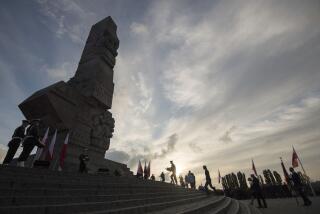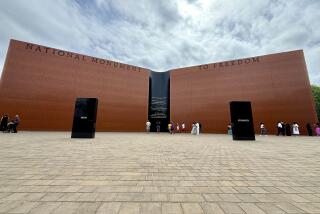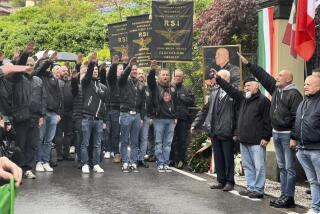Soviets Offer Memorial to Repression Victims : Political prisons: A boulder from an island camp is a reminder of millions tortured or murdered.
MOSCOW — A memorial to the millions killed or imprisoned during the political repressions of past Soviet regimes was unveiled Tuesday in the shadow of the building where many of them had been tortured and murdered.
Thousands of people carrying flowers and photographs of victims marched passed Lubyanka, the central building of the KGB, the Soviet state security and espionage agency.
They gathered at dusk in a small park across the square to honor victims of repression under former Soviet leaders Josef Stalin, Nikita S. Khrushchev and Leonid I. Brezhnev.
“It’s not just a building--this building is a symbol of unlawfulness, inhumanity and injustice,” Yuri N. Afanasyev, a well-known historian and liberal member of the Congress of People’s Deputies, the national Parliament, said as he gestured toward Lubyanka.
“There has never in human history been such a phenomenon as the Soviet regime’s devastating war against its own people over the last 70 years.”
Former prisoners held signs with the names of the camps where they served sentences on political charges for offenses as small as debating with friends about a decision by Stalin.
Some participants displayed banners with slogans such as “The KGB has not cleaned the blood from itself” and “Where there is violence, there crime reigns.”
The new memorial, a gray boulder, had been transported by ship from the Solovetsky Islands prison camp, a former monastery that was turned into a political prison in the early 1920s, to its new home near the statue of Felix Dzherzhinsky, a Polish aristocrat who founded the KGB’s forerunner, the Cheka.
“This memorial is a symbol of our inexhaustible grief over the millions of people who perished before seeing justice,” Sergei B. Stankevich, deputy mayor of Moscow, said during the dedication ceremony.
A simple inscription on a marble ledge underneath the large stone reads: “This rock, brought here from the territory of the Solovetsky Camp by the Memorial Society, was placed as a memorial to the millions of victims of totalitarian regimes on Oct. 30, 1990, the day of political prisoners in the Soviet Union.”
The Memorial Society, formed two years ago by leading human rights advocates including the late physicist and Nobel Peace Prize laureate Andrei D. Sakharov, decided to place the boulder in the small park as an interim measure until a full-scale monument can be built.
After the boulder was unveiled, Father Gleb Yakunin, a Russian Orthodox priest and longtime dissident who is now a member of the Parliament of the Russian Federation, prayed for the victims of the “godless power” that ruled the country.
“Lord forgive us,” a church choir sang. “Lord forgive us.”
Thousands of people, surging forward to see the memorial, showered the boulder with hundreds of red, white and pink flowers.
“This memorial will be a symbol of hope for the future for me and for my son,” said Yevgeni T. Sorenko, 55. He held a poster with a picture of his father above a drawing of a barbed-wire fence and the words “One of the Many.”
Most of the crowd seemed to have personally suffered from the repressions, either by losing their loved ones or by spending years behind prison walls unjustly.
“It is an emotionally difficult day for us, but we want to be sure the terror will never be repeated,” Interna D. Fedotova, 63, said as she held a photograph of her father, who was shot in 1938. “I’m glad there are some young people here. It’s important that our children and grandchildren do not forget what kind of horrible life we had.”
More to Read
Sign up for Essential California
The most important California stories and recommendations in your inbox every morning.
You may occasionally receive promotional content from the Los Angeles Times.










